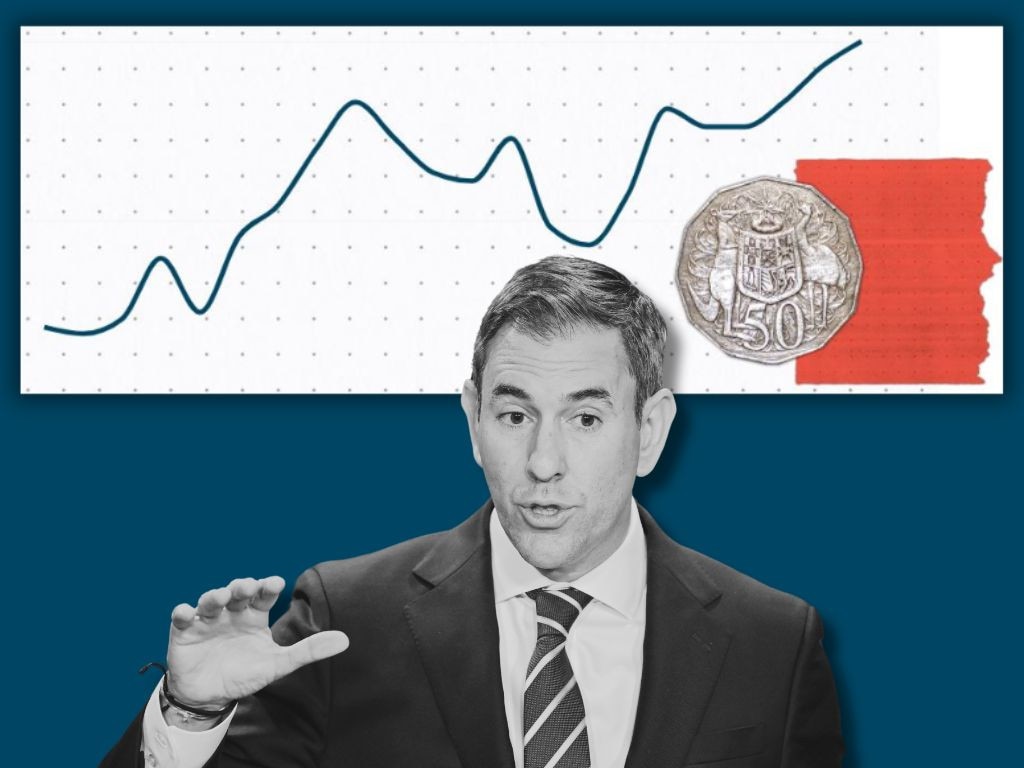Bracket creep wipes tax cuts
Why taxpayers are set to lose more than $5000 a year despite the tax cut handed down in the federal budget.
The average taxpayer stands to lose almost $5000 due to inflation-fuelled bracket creep by 2029 despite Labor’s latest round of tax cuts, with the federal budget’s increasing reliance on the so-called stealth tax disproportionately affecting low-income earners.
Jim Chalmers unveiled a fresh round of income tax cuts in Tuesday’s federal budget, which will reduce the existing 16 per cent tax rate on income earned between $18,200 and $45,000 to 15 per cent in mid-2026.
The rate will fall to 14 per cent after a year and subsequently hold at that level.
As a consequence, every taxpayer will receive a new tax cut worth up to $268 in 2026-27 – or roughly $5 a week – with the reduction to increase to as much as $536 in 2027-28, relative to the existing tax settings.
Analysis by The Australian using the Parliamentary Budget Office’s income tax tool shows a worker on an income earning between $100,000 and $150,000 can expect to pay up to a cumulative $5200 extra in income tax by mid-2029 because of bracket creep.
Similarly, a worker earning between $50,000 and $100,000 will lose as much as $4830 due to bracket creep over the same four year period.
A high-income earner making between $150,000 and $200,000, by contrast, will forgo up to $8430.
The analysis is predicated on benchmarking the current tax settings against an alternative hypothetical scenario whereby tax bracket thresholds are indexed annually at the rate of Treasury’s wage growth projections, or about 3.5 per cent.
Under the latter scenario, the tax-free threshold would lift from its current level of $18,200 to $20,855 by mid-2029, while the top tax threshold, now pegged at $190,000, would rise to $218,029.
Bonuses and other one-off payments, as well as promotions to a higher-earning role, are excluded from Treasury’s wage gauge, meaning such compensation would push the amount clawed back by bracket creep higher still.
The Australian’s analysis shows that a worker on $120,000 in 2024-25 who receives a promotion in five years and another in 10 years on top of annual increases in line with regular wages growth, would jump well over the tax bracket threshold at $135,000. Across 10 years they would end up paying cumulatively more than $80,000 more in tax through pay increases, reducing their extra earnings and dwarfing the $4556 benefit from Labor’s new tax cuts over that time.
For a worker on $140,000 in 2024-25, using the same scenario, their total tax bill would increase by more than $106,000 over 10 years, as they jump into the top tax bracket above the $190,000 threshold.
The Treasurer made the change in a bid to temporarily ease a phenomenon known as bracket creep which occurs when wages growth pushes a greater portion of workers’ wages and salaries into higher tax brackets, subsequently reducing their take home pay.
Among the 38 OECD member countries, just four, including Australia, do not automatically adjust their tax brackets to neuter the impact of wages growth.
Delivering a post-budget address on Wednesday, Dr Chalmers defended the reliance on growing income tax receipts to meet growing spending pressures, and dismissed calls for the annual indexation of tax brackets.
“We’ve got to make the budget add up,” Dr Chalmers told the National Press Club. “There are good reasons to index parts of our economic armoury – social security and the like,” he added. “But we’ve found a different, I think better, way to return bracket creep now three times.”
While the Coalition has decried the growing burden of personal income taxes, opposition Treasury spokesman Angus Taylor has similarly not announced any plans to eliminate bracket creep, instead pledging to reduce inflation to help “beat” the tax grab. Many economists have previously warned that the federal budget is becoming overly dependent on levying personal incomes as workers increasingly bear the brunt of funding the growth in government spending.
Revenue projections contained in Tuesday’s federal budget papers forecast that personal income taxes would rise to 54 per cent of the overall tax base by the end of the forward estimates period, prompting calls for a shake-up to Australia’s revenue mix.
David Bassanese, chief economist at Betashares, nominated bracket creep as among the top challenges facing the nation’s finances, warning that the issue had not been sufficiently addressed in Labor’s fourth federal budget.
“Sadly, but not surprisingly, little has been done in this budget to address longstanding structural issues such as the over reliance on bracket creep and personal income taxation to fund government spending,” he said.
Alex Halbherr, a father of two who lives with his children and wife Melanie in Croydon in Melbourne’s east, said a recent $7000 pay increase had pushed him into the top tax bracket. “It’s not great. I knew it was coming eventually, but it is frustrating that now for every extra dollar that you earn it’s gone from 37c on the dollar to 45c on the dollar, so nearly half of every extra dollar (earned) goes into taxes,” he said. “It doesn’t feel like your pay rise is actually all that it’s cracked out to be.”
Mr Halbherr said he was pleased to see further tax cuts in Tuesday’s budget, stating that the increase in his take-home pay would “absolutely” make a difference for his family of two.







To join the conversation, please log in. Don't have an account? Register
Join the conversation, you are commenting as Logout